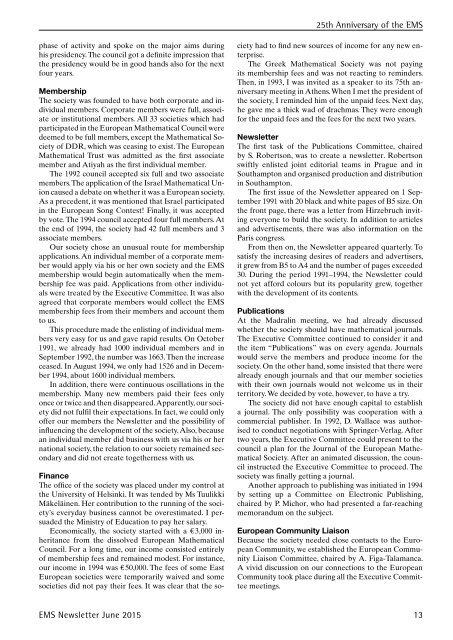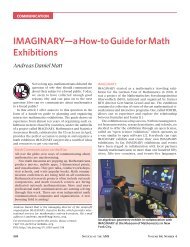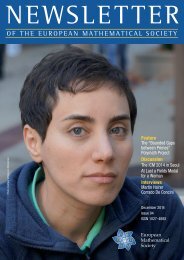2015-06-96
2015-06-96
2015-06-96
- No tags were found...
Create successful ePaper yourself
Turn your PDF publications into a flip-book with our unique Google optimized e-Paper software.
25th Anniversary of the EMSphase of activity and spoke on the major aims duringhis presidency. The council got a definite impression thatthe presidency would be in good hands also for the nextfour years.MembershipThe society was founded to have both corporate and individualmembers. Corporate members were full, associateor institutional members. All 33 societies which hadparticipated in the European Mathematical Council weredeemed to be full members, except the Mathematical Societyof DDR, which was ceasing to exist. The EuropeanMathematical Trust was admitted as the first associatemember and Atiyah as the first individual member.The 1992 council accepted six full and two associatemembers. The application of the Israel Mathematical Unioncaused a debate on whether it was a European society.As a precedent, it was mentioned that Israel participatedin the European Song Contest! Finally, it was acceptedby vote. The 1994 council accepted four full members. Atthe end of 1994, the society had 42 full members and 3associate members.Our society chose an unusual route for membershipapplications. An individual member of a corporate memberwould apply via his or her own society and the EMSmembership would begin automatically when the membershipfee was paid. Applications from other individualswere treated by the Executive Committee. It was alsoagreed that corporate members would collect the EMSmembership fees from their members and account themto us.This procedure made the enlisting of individual membersvery easy for us and gave rapid results. On October1991, we already had 1000 individual members and inSeptember 1992, the number was 1663. Then the increaseceased. In August 1994, we only had 1526 and in December1994, about 1600 individual members.In addition, there were continuous oscillations in themembership. Many new members paid their fees onlyonce or twice and then disappeared. Apparently, our societydid not fulfil their expectations. In fact, we could onlyoffer our members the Newsletter and the possibility ofinfluencing the development of the society. Also, becausean individual member did business with us via his or hernational society, the relation to our society remained secondaryand did not create togetherness with us.FinanceThe office of the society was placed under my control atthe University of Helsinki. It was tended by Ms TuulikkiMäkeläinen. Her contribution to the running of the society’severyday business cannot be overestimated. I persuadedthe Ministry of Education to pay her salary.Economically, the society started with a € 3,000 inheritancefrom the dissolved European MathematicalCouncil. For a long time, our income consisted entirelyof membership fees and remained modest. For instance,our income in 1994 was € 50,000. The fees of some EastEuropean societies were temporarily waived and somesocieties did not pay their fees. It was clear that the societyhad to find new sources of income for any new enterprise.The Greek Mathematical Society was not payingits membership fees and was not reacting to reminders.Then, in 1993, I was invited as a speaker to its 75th anniversarymeeting in Athens. When I met the president ofthe society, I reminded him of the unpaid fees. Next day,he gave me a thick wad of drachmas. They were enoughfor the unpaid fees and the fees for the next two years.NewsletterThe first task of the Publications Committee, chairedby S. Robertson, was to create a newsletter. Robertsonswiftly enlisted joint editorial teams in Prague and inSouthampton and organised production and distributionin Southampton.The first issue of the Newsletter appeared on 1 September1991 with 20 black and white pages of B5 size. Onthe front page, there was a letter from Hirzebruch invitingeveryone to build the society. In addition to articlesand advertisements, there was also information on theParis congress.From then on, the Newsletter appeared quarterly. Tosatisfy the increasing desires of readers and advertisers,it grew from B5 to A4 and the number of pages exceeded30. During the period 1991–1994, the Newsletter couldnot yet afford colours but its popularity grew, togetherwith the development of its contents.PublicationsAt the Madralin meeting, we had already discussedwhether the society should have mathematical journals.The Executive Committee continued to consider it andthe item “Publications” was on every agenda. Journalswould serve the members and produce income for thesociety. On the other hand, some insisted that there werealready enough journals and that our member societieswith their own journals would not welcome us in theirterritory. We decided by vote, however, to have a try.The society did not have enough capital to establisha journal. The only possibility was cooperation with acommercial publisher. In 1992, D. Wallace was authorisedto conduct negotiations with Springer-Verlag. Aftertwo years, the Executive Committee could present to thecouncil a plan for the Journal of the European MathematicalSociety. After an animated discussion, the councilinstructed the Executive Committee to proceed. Thesociety was finally getting a journal.Another approach to publishing was initiated in 1994by setting up a Committee on Electronic Publishing,chaired by P. Michor, who had presented a far-reachingmemorandum on the subject.European Community LiaisonBecause the society needed close contacts to the EuropeanCommunity, we established the European CommunityLiaison Committee, chaired by A. Figa-Talamanca.A vivid discussion on our connections to the EuropeanCommunity took place during all the Executive Committeemeetings.EMS Newsletter June <strong>2015</strong> 13






